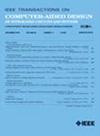用于突触启发人工神经网络的FDSOI FET评价
IF 2.9
3区 计算机科学
Q2 COMPUTER SCIENCE, HARDWARE & ARCHITECTURE
IEEE Transactions on Computer-Aided Design of Integrated Circuits and Systems
Pub Date : 2025-03-18
DOI:10.1109/TCAD.2025.3552664
引用次数: 0
摘要
在本文中,一个校准良好的FDSOI铁电(Fe)-FET/ ffet与电荷阱氮化物(CTN)栅极堆叠,用于研究记忆和突触应用。CTN夹在FeFET的Fe和硅通道之间,以获得铁电/氧化物/氮化物/氧化物/半导体(FONOS) FET,用于改善记忆和突触应用。这种同时使用Fe和CTN层来改善记忆和突触应用的方法被称为混合方法。因为,无论是Fe还是CTN作为一个独立的门栈电介质,都可以给出阈值电压($V_{T}$)位移,从而导致迟滞转移特性与预测内存窗口(MW)的程序(PGM)/擦除(ERS)方案。ffet使用自发极化($P_{S}$)来获得低功耗和低面积的存储操作。CTN采用高度成熟、可靠的基于电荷捕获记忆(CTM)的e ${}^{-} $ /h+捕获$\Leftrightarrow $脱陷机制,结合PGM/ERS方案,获得具有高$V_{T}$ (HVT)和低$V_{T}$ (LVT)传输特性的MW。因此,这些组合导致FONOS FET架构,该架构被研究用于改善记忆特性,如MW和保留率,然后检查突触属性,以实现对人工神经网络(ann)的实际设备训练精度。研究结果表明:1)在8 nm厚的CTN层上,FONOS存储器件预测了2.65 V时的MW提高,fe电场($E_{\mathrm { Fe}}$)和电荷密度的保留时间为$\approx 11$年;2)突触器件的精度为93% for MNIST digit dataset in ANNs. These predictions from the FONOS FET aimed at providing hybrid solutions to next-generation devices with extended applications in memory and neuromorphic applications with reliable device operation.本文章由计算机程序翻译,如有差异,请以英文原文为准。
Evaluation of FONOS FDSOI FET for Synapse-Inspired Artificial Neural Network
In this article, a well calibrated FDSOI ferroelectric (Fe)-FET/FeFET is gate-stacked with a charge trap nitride (CTN) for investigating memory and synaptic applications. The CTN is sandwiched between Fe and silicon channel of FeFET to obtain ferroelectric/oxide/nitride/oxide/semiconductor (FONOS) FET for improved memory and synaptic applications. This approach of using both Fe and CTN layers to improve memory and synaptic applications is labeled as hybrid approach. Since, both the Fe or CTN as a standalone gate-stack dielectric can give threshold-voltage ( $V_{T}$ ) shift leading to hysteresis transfer characteristics with a program (PGM)/erase (ERS) schemes that predict a memory window (MW). The FeFET uses spontaneous polarization ( $P_{S}$ ) to obtain memory operation which offer low power and area. The CTN uses highly mature and reliable charge-trapping-memory (CTM)-based e ${}^{-} $ /h+ trapping $\Leftrightarrow $ de-trapping mechanism with PGM/ERS scheme to obtain MW that has high- $V_{T}$ (HVT) and low- $V_{T}$ (LVT) transfer characteristics. Hence, a combination of these leading to a FONOS FET architecture, which is investigated for improved memory properties like MW and retention followed by examining on synaptic attributes for realistic device training accuracy toward artificial neural networks (ANNs). From the investigations: 1) FONOS memory device has predicted improvement in MW with 2.65 V for 8-nm thick CTN layer and retention of Fe-electric field ( $E_{\mathrm { Fe}}$ ) and charge density for $\approx 11$ years and 2) synaptic device has shown an accuracy of 93% for MNIST digit dataset in ANNs. These predictions from the FONOS FET aimed at providing hybrid solutions to next-generation devices with extended applications in memory and neuromorphic applications with reliable device operation.
求助全文
通过发布文献求助,成功后即可免费获取论文全文。
去求助
来源期刊
CiteScore
5.60
自引率
13.80%
发文量
500
审稿时长
7 months
期刊介绍:
The purpose of this Transactions is to publish papers of interest to individuals in the area of computer-aided design of integrated circuits and systems composed of analog, digital, mixed-signal, optical, or microwave components. The aids include methods, models, algorithms, and man-machine interfaces for system-level, physical and logical design including: planning, synthesis, partitioning, modeling, simulation, layout, verification, testing, hardware-software co-design and documentation of integrated circuit and system designs of all complexities. Design tools and techniques for evaluating and designing integrated circuits and systems for metrics such as performance, power, reliability, testability, and security are a focus.

 求助内容:
求助内容: 应助结果提醒方式:
应助结果提醒方式:


